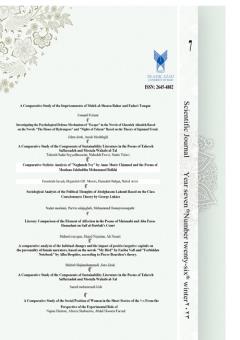A Comparative Study of the Components of Sustainability Literature in the Poems of Tahereh Saffarzadeh and Mostafa Wahabi al-Tal
Subject Areas : Comparative Literature Studies
Tahereh Sadat Tahereh Sadat Seyyedhosseini
1
![]() ,
Nahedeh Fawzi
2
,
Nahedeh Fawzi
2
![]() ,
Simin Valavi
3
,
Simin Valavi
3
1 - Ph.D. Candidate, Department of Persian Language and Literature, Central Tehran Branch, Islamic Azad University, Tehran, Iran.
2 - Assistant Professor, Department of Persian Language and Literature, Central Tehran Branch, Islamic Azad University, Tehran, Iran.(Corresponding Author)
3 - Associate Professor, Department of Persian Language and Literature, Central Tehran Branch, Islamic Azad University, Tehran, Iran.
Keywords: Sustainability, homeland, Sustainability literature, tahereh safarzadeh, Anti-arrogance, Wahabi Al-Tal,
Abstract :
Sustainability literature is one of the important branches of literature with emphasis on concepts such as standing, resistance, patriotism, negation of tyranny and arrogance, which are mainly written due to conditions such as war, military occupation, suffocation, tyranny and repression, and things like common pains, standing for freedom, praising the dead and drawing a bright future are its common axes. An important issue is the application of the components of sustainability literature in the literature of different societies. In other words, most of the poets and writers who have experienced events such as war, military occupation, repression, etc. by foreign forces and even internal despotic elements, have used various components in their poetry and prose works. This article is a research on the comparative analysis of the components of sustainable literature in the poetry of Iranian poet Tahereh Saffarzadeh and Jordanian poet and writer Mostafa Wahabi Al-Tal. The hypothesis of the article tells about the fact that the three components of striving for the freedom of the homeland, call to fight and persistence and anti-arrogance are the common components of the sustainability literature of these two poets. The findings of the article using the comparative method showed that both authors have used religious myths to explain the component of patriotism. Regarding the element of invitation to fight, both poets have used three approaches. First; creating hope and unity among the fighters, second; drawing a bright and third future; honoring the martyrs of resistance and standing. Finally, regarding the anti-arrogance component, both poets first compare the occupiers to vicious and predatory animals, and then call the fighters to a revolution.
_||_


